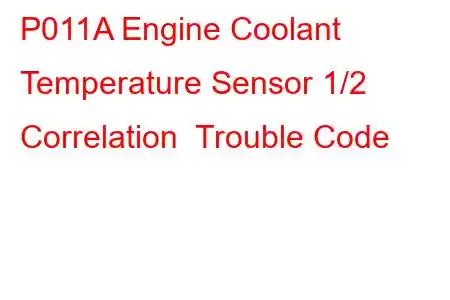P011A Engine Coolant Temperature Sensor 1/2 Correlation
OBD-II Trouble Code Technical Description
Engine Coolant Temperature Sensor 1/2 Correlation
What does that mean?
This generic powertrain diagnostic trouble code (DTC) typically applies to all OBD-II vehicles. That may include but is not limited to vehicles from Mazda, Land Rover, GMC, Chevy, Ford, Dodge, Chrysler, Toyota, Honda, etc. Although generic, the specific repair steps may vary depending on make/model.
On the rare occasion that a code P011A is stored in an OBD-II vehicle, it means that the powertrain control module (PCM) has detected a problem with the correlating signals between two separate engine coolant temperature (ECT) sensors.
These sensors have been designated as A and B but could also be called primary and secondary. Obviously, this code is used only in vehicles with multiple ECT sensors.
Typically, ECT sensors are composed of a thermal resistor that is surrounded by a durable resin in a brass, aluminum, or plastic housing. The housing is designed to thread into the engine block, radiator, intake manifold (coolant passage), or cylinder head. The ECT sensor is shaped and positioned so that, once the thermostat has opened, engine coolant may flow across the tip. The exposed resistor is in the tip of the sensor.
As the flowing engine coolant temperature increases, the level of resistance in the ECT resistor decreases. This allows circuit voltage to increase. The PCM recognizes these variations in ECT voltage as changes in engine coolant temperature.
The ECT sensor/s provides data to the PCM, for drivability strategy and electronic cooling fan operation, but may also serve to provide a signal to the temperature gauge in the instrument cluster.
If the PCM detects independent voltage signals from the separate ECT sensors which differ by more than a preprogrammed degree, a code P011A will be stored and a malfunction indicator lamp (MIL) may be illuminated. Multiple failure cycles may be required for MIL illumination on certain models.
What is the severity of this code?
Since engine drivability, electronic cooling fan operation, and/or temperature gauge accuracy may be effected by the conditions which contribute to a code P011A being stored, it should be considered severe.
What are some of the symptoms of the code?
Symptoms of a P011A engine code may include:
Excessive rich or lean exhaust Rough engine idle (especially at cold start up) Diminished fuel efficiency Decreased engine performanceWhat are some of the possible causes of the code?
Causes for this code may include:
Defective ECT sensor Open or shorted ECT sensor wiring or connector Low engine coolant condition Bad thermostat Faulty water pump Air pocket in engine cooling system PCM or PCM programming errorWhat are some P011A troubleshooting steps?
I like to have access to a diagnostic scanner, a digital volt/ohmmeter (DVOM), and a reliable vehicle information source before attempting to diagnose a code P011A.
Before beginning my diagnosis for any ECT sensor related code, I would make sure that the engine cooling system is filled to the proper level with the correct coolant. Operate the engine to ensure that the thermostat, water pump, radiator, and cooling fans are all working as intended. Ensure that there are no air pockets in the cooling system. The engine cooling system must be working properly before this code can be diagnosed.
Once the cooling system is operating normally, visually inspect all system wiring and connectors and make repairs as required.
Next, I would connect the scanner to the vehicle diagnostic port and retrieve all stored codes and freeze frame data. Freeze frame data is a snap shot of the exact circumstances which were occurring at the time of the failure that led to the stored code P011A. I usually w
Read: 43


